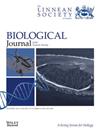The challenge of incorporating ex situ strategies for jaguar conservation
IF 1.5
3区 生物学
Q3 EVOLUTIONARY BIOLOGY
引用次数: 0
Abstract
The loss of biodiversity is an ongoing process and existing efforts to halt it are based on different conservation strategies. The ‘One Plan approach’ introduced by The International Union for Conservation of Nature proposes to consider all populations of a species under a unified management plan. In this work we follow this premise in order to unify in situ and ex situ management of one of the most critically endangered mammals in Argentina, the jaguar (Panthera onca). We assessed pedigrees of captive animals, finding that 44.93% of the reported relatedness was erroneous according to molecular data. Captive individuals formed a distinct genetic cluster. The three remaining locations for jaguars in Argentina constitute two genetic groups, the Atlantic Forest and the Chaco–Yungas clusters. Genetic variability is low compared with other populations of the species in the Americas and it is not significantly different between wild and captive populations in Argentina. These findings demonstrate that genetic studies aiming to include captive individuals into conservation management are very valuable, and should incorporate several parameters such as mean individual relatedness, individual inbreeding, rare and private alleles, and mitochondrial haplotypes. Finally, we discuss two ongoing ex situ management actions and postulate the need for genetic monitoring of the breeding and release of animals.在美洲虎保护工作中采用异地战略的挑战
生物多样性的丧失是一个持续的过程,目前为阻止这一过程所做的努力基于不同的保护战略。国际自然保护联盟提出的 "一个计划方法 "建议将一个物种的所有种群都纳入一个统一的管理计划中。在这项工作中,我们遵循这一前提,对阿根廷最濒危的哺乳动物之一美洲豹(Panthera onca)进行统一的原地和异地管理。我们对圈养动物的血统进行了评估,发现根据分子数据,44.93% 的亲缘关系报告是错误的。圈养个体形成了一个独特的基因群。阿根廷美洲虎的其余三个分布区构成了两个基因群,即大西洋森林群和查科-永加斯群。与美洲其他种群相比,阿根廷美洲虎的遗传变异率较低,野生种群和人工饲养种群之间的遗传变异率也没有显著差异。这些研究结果表明,旨在将人工饲养个体纳入保护管理的遗传研究非常有价值,并应纳入多个参数,如平均个体亲缘关系、个体近交、稀有和私有等位基因以及线粒体单倍型。最后,我们讨论了两个正在进行的异地管理行动,并提出了对动物繁殖和释放进行遗传监测的必要性。
本文章由计算机程序翻译,如有差异,请以英文原文为准。
求助全文
约1分钟内获得全文
求助全文
来源期刊
CiteScore
4.30
自引率
10.50%
发文量
140
审稿时长
3-6 weeks
期刊介绍:
The Biological Journal of the Linnean Society is a direct descendant of the oldest biological journal in the world, which published the epoch-making papers on evolution by Darwin and Wallace. The Journal specializes in evolution in the broadest sense and covers all taxonomic groups in all five kingdoms. It covers all the methods used to study evolution, whether whole-organism or molecular, practical or theoretical.d.

 求助内容:
求助内容: 应助结果提醒方式:
应助结果提醒方式:


